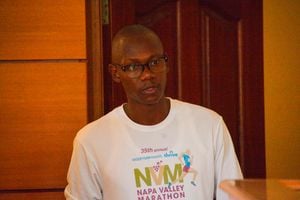Will Kinyanjui gains serve to resist Kihika onslaught in Nakuru?

Nakuru Governor Lee Kinyanjui and Nakuru Senator Susan Kihika. The two are the leading contestants in the 2022 Nakuru gubernatorial race.
What you need to know:
Nakuru Fact File:
- Area: 7,510km2
- Population: 2.162 million (2019)
- Voters: 949, 618
- Constituencies: Bahati, Gilgil, Kuresoi North, Kuresoi South, Molo, Nakuru Town West, Nakuru Town East, Naivasha, Njoro, Rongai, Subukia
One of the toughest gubernatorial battles in the August 9 polls in the vote-rich Rift Valley is bound to be witnessed in Nakuru County, the home of Kenya’s newest city.
It’s the making of an epic political contest between Governor Lee Kinyanjui (Jubilee Party) and Senator Susan Kihika (United Democratic Alliance, UDA).
In the 2017 elections, Mr Kinyanjui garnered 632,740 votes out of the 949,618 registered voters to win the gubernatorial contest while Ms Kihika won the Senate seat with 672,343 votes.
The race has also attracted two independent candidates—Dr Stanley Karanja and former Senator James Mungai.
Read more: Focus on 2022 gubernatorial races
Several issues including national politics, voting patterns, party popularity, development track record, business communities, nominations fallout and the unresolved land issues could influence the elections outcome.
The political split of the Kikuyu and Kalenjin communities, who will most likely not vote as a block for the first time since 2013, a huge number of undecided voters, mobilisation skills, campaign financing and choice of a running mate will also be key.
Youth unemployment, insecurity, revival of the pyrethrum sub-sector, issuance of title deeds, water, infrastructure, affordable housing, healthcare and accountability are some of the key priorities that the residents will evaluate as they prepare to vote for the next governors.
Mr Kinyanjui, an ally of President Kenyatta, has gained national attention as a possible running mate for Azimio la Umoja One Kenya Coalition Party Presidential hopeful Raila Odinga.
The titanic battle presents a big headache for President Kenyatta and his Deputy William Ruto as a win for Jubilee will cement Mr Kenyatta’s hold in the region and a defeat will mean his deputy has beaten him hands down, giving the UDA boss the bragging rights.
“A win for Jubilee will be a big plus to Mr Kenyatta while a win for UDA will mean Dr Ruto has turned the tables on his boss,” Mr Andrew Kibet, a resident of Kuresoi North, said.
For Mr Odinga, a win for Jubilee will give him significant political mileage in a region that is firmly in the grips of his rival, DP Ruto.
Mr Kinyanjui abandoned plans to defend the seat on an Ubuntu People Forum (UPF) party ticket and a win will be a major boost for Jubilee Party’s waning popularity in the region.
Ms Kihika is riding on a populist UDA wave in her bid to clinch the seat. The former county assembly Speaker has constantly criticised Mr Kinyanjui’s administration in her campaigns in between popularising her party’s “bottom-up” economic approach.
For the two leaders, the battle will narrow down to the support in the constituencies, with parliamentary election outcomes expected to be good indicators of where the chips might fall.
In Ms Kihika’s corner are Kuresoi South MP Joseph Tonui, his Kuresoi North counterpart Moses Cheboi, who lost to Alfred Mutai, Njoro’s Charity Kathambi, Martha Wangari of Gilgil, Samuel Gachobe of Subukia, Molo’s Kuria Kimani and Nakuru Town East’s David Gikaria.
Also seen to be at odds with Ms Kihika, but who is a member of UDA, is Naivasha’s Jayne Kihara, who won controversially against former MP John Kihagi. Mr Kinyanjui enjoys the support of Nakuru Town West MP Samwel Arama and Rongai’s Raymond Moi.
Independent Electoral and Boundaries Commission data from 2017 shows Naivasha has 145,049 voters, Njoro (104,687), Nakuru Town East (112,744), Nakuru Town West (97,549), Bahati (87,508), Gilgil (85340), Rongai (77,162), Molo (70,992), Kuresoi North and Subukia (61,344) and Kuresoi South 55,661.
Mr Kinyanjui scored a significant win with the historic elevation of Nakuru Town into a city. Interestingly, Ms Kihika vehemently opposed the elevation and wanted it deferred for 10 years, arguing that Nakuru was not ripe for city status. While she voted for the elevation of the town at the Senate, she insisted that it was not an endorsement of Mr Kinyanjui’s leadership.
Also Read: Kihika isolated in UDA Nakuru primaries
“Attacking Mr Kinyanjui’s development agenda at the Senate was a display of political cowardice. Mr Kinyanjui’s leadership has stains but he is not known to preach politics of hatred, malice and vendetta. This may come to haunt Ms Kihika’s bid,” Mr George Omondi, a political analyst, said.
The governor is also credited with the revival of the pyrethrum sub-sector, infrastructural development, pushing for construction of Nakuru Airport in Lanet and the upgrade of the Nakuru Level Five Hospital to the tune of Sh600 million.
Mr Kinyanjui is also credited with promoting a more inclusive public service compared to his predecessor, Mr Kinuthia Mbugua, which has seen minority communities get jobs in the county government.
However, Mr Kinyanjui’s administration has some glaring dents.
The dwindling revenue collection, rising wage bill that has hit more than Sh7 billion, and a centralised procurement system that is struggling to clear pending bills worth more than Sh2billion. The underfunding of the ward and sub-county administrators who are largely idle is another glaring stain in his development track record. Mr Kinyanjui says the centralisation of the procurement system has reduced corruption. The voting patterns of the business community, matatu owners and small-scale traders will also determine the winner. Ms Kihika is confident of winning the seat.
“I have a unique insight of the challenges facing the county having worked with MCAs as their Speaker,” she said in a past interview with the Nation.
Top on her agenda are healthcare, provision of clean water, youth unemployment, reducing the high cost of doing business, provision of cheaper farm inputs and value addition. Battleground constituencies are Nakuru Town East, Nakuru Town West and Naivasha and Njoro and whoever wins in them is likely to emerge the overall winner.
“Mr Kinyanjui”s development projects are transforming the lives of the residents. He deserves a second term,” said Mr Joseph Talam, a resident of the Rongai sub-county.
“The governor’s faces an uphill battle in a county that is leaning heavily towards UDA,” said Mr Benson Machari, an activist.
Mr Kinyanjui hopes to make up for the lost Kalenjin vote by galvanising minority communities who support the Azimio la Umoja One Kenya Coalition Party.
Mr Omondi said that, in 2017 Mr Odinga got about 300,000 votes without the support of the Kikuyu and Kalenjin and these are the votes that Mr Kinyanjui will be banking on.
“Kikuyu votes are still the main battleground. Chances are that 45 per cent of the community might vote for Mr Kinyanjui while 55 per cent might vote for Ms Kihika. These are provision percentages and anything can happen ahead of the elections," said Mr Omondi.
The latest statistics from IEBC indicate that 58 per cent of Nakuru voters are from the populous Kikuyu community, 24 per cent are Kalenjin and 18 per cent are from minority communities.
Mr Kinyanjui may, however, get votes from disgruntled UDA supporters who feel that its nominations were bungled, analysts observe.
Also Read: Kinyanjui gets Jubilee nod to defend seat
DNation bodytext: “Unhappy UDA supporters are unlikely to vote for Ms Kihika and that could be detrimental to her gubernatorial bid,” said Mr Omondi. Unresolved land issues feature prominently in political discussions.
“I will vote in a governor who will assure me of my security. I'm tired of living like an internally displaced person,” says Ms Margaret Wakahiu, a farmer in Kuresoi North. Mr Mungai, who made his first attempt for the gubernatorial seat in 2017 on an independent ticket, is making a second attempt to win the seat.
Dr Karanja says his entry into the race is driven by a desire to take the county to the next level of development by focusing on key economic pillars like agriculture, environment, housing, infrastructure, security, conducive business environment, youth and women empowerment.
“I want to offer good leadership to the county’s over two million residents,” said Dr Karanja.





